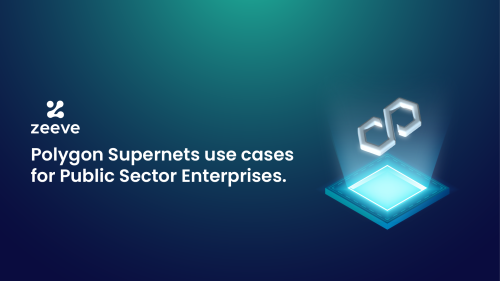
Polygon Supernets use cases for Public Sectors Enterprises
Polygon Supernets is a new-age AppChain framework that allows a variety of enterprises, including public sectors, to launch custom-fitted, application-oriented blockchains. Talking about the public sector, we have seen that the iteration of technologies encourages these enterprises to upgrade their infrastructure and become more efficient over time. Due to this, many government agencies and public sector enterprises might be soon shifting to AppChains to enhance transparency, security, and immutability in their ecosystem while stimulating economic growth.
AppChains provides public sector enterprises with a range of benefits like compliance implementation options–including infrastructure customization, the ability to launch their own tokenomics, flexibility in adding additional security features, on-chain governance, and full control over the network participants and their actions. AppChains allow businesses to build independent blockchain with both the features of public and permissive blockchains. For example, you can build a private blockchain and will still benefit from the security of public blockchain. Hence, we can expect to see migration of more enterprises to Appchains in future. Now, let’s explore the use cases of Polygon Supernets for public sector enterprises to understand how they can revamp their existing ecosystem and leverage the benefits of AppChains.

What are the Polygon Supernets use cases for Public Sector Enterprises?
Polygon Supernets is a product suite that supports the development of the sovereign blockchain. AppChains are useful for public sector enterprises that have to manage dApps with large volumes of data and huge numbers of users. Also, AppChain is a viable choice if you seek to customize the blockchain ecosystem based on the use case-specific parameters. Now, let’s explore the potential use case of Polygon Supernets for public sector enterprises:
Read More: A Complete Guide On Polygon Supernets
- Digital identity verification and data security:
Identity verification and management could be one major use case for Polygon Supernet in public sector enterprises. With Supernets, companies can create a highly flexible and tailored blockchain that stores sensitive information about people and their identities while granting data access only to authorized members. Also, as opposed to a general-purpose blockchain that shares security with various dApps, Supernets inherit security directly from the underlying Layer-1 blockchain (Polygon PoS or Ethereum). Thereby, the Supernets ecosystem tackles the issues with identity verification and data management, such as insecurity, identity theft, and unauthorized access.
- Smart supply Chain ecosystem:
Polygon Supernets tackle all the challenges of blockchain in the supply chain, such as data integrity, granting access to the right people, and difficulty in regulation/compliance. For example, supply chain solutions built with Supernets can be customized for specific permissioning parameters, for example, who can verify the data, who can publish data, and who can access the information. Hence, the whole supply chain system becomes highly secure, traceable, and efficient. Plus, having a dedicated ecosystem will automatically improve the response time and transaction throughput with no chance of network congestion since the blockchain will only have a single use case for supply chain management.
- Settlement of cross-border transactions:
Cross-border payments on a public blockchain ecosystem perform well, but they may create challenges when the volume of transactions grows dramatically. The challenges can be slow transaction processing, high fees, regulatory barriers, and currency fluctuations. That’s so because public sector enterprises like banks and other financial institutions handle a bulk of cross-border transactions on a daily basis. But imagine if a blockchain application existed that runs on an independent blockchain infrastructure and is optimized just for handling cross-border transactions related to public sector enterprises such as international trade, economic activities, tourism, remittance, etc.
Polygon supernets provide a reliable ecosystem to build and manage solutions that simplify cross-border transactions with features like permissioned and public infrastructure, on-chain governance mechanism, ability to customize blockchain-level parameters such as who can deploy smart contracts, who can be validators, and who all can post transactions. This way, AppChain, built with Supernets, tackles all the challenges public sector institutions face while managing cross-border payments on general-purpose public and permissive blockchains.
- Healthcare records management:
Healthcare in the public sector, such as local, regional, and national-level hospitals, produces a lot more data compared to the private sectors. Government agencies use blockchain to maintain the security and immutability of this information. However, being on a public blockchain, the information on healthcare records is stored in an open database, and each application user has a copy of the data. While many patients do not want their medical problems to be public, which means their privacy is hampered here. Having a dedicated App-chain is a good way to maintain healthcare records and configure the access parameters, defining who can see the details and who cannot. If required on a certain level, the AppChain ecosystem can be configured further to achieve the public blockchain’s abilities to make some information publicly available.
- Tax collection and compliance:
Government agencies all across the world have been using blockchain-based solutions to drive improvements in tax collection, documentation, and tax assessment. Tax agencies have to maintain compliance despite the policy evolution over time. Also, data related to taxation needs to be recorded across a highly secure and interoperable environment. Using Polygon Superntes, tax management authorities can create an application-specific blockchain to be used just to handle tax procedures and taxation data. Supenets offer an on-chain governance feature, allowing administrators to make changes in their blockchain as required. Plus, the security enabled by Supernets is exceptional, which ensures there’s no tampering or unauthorized access to the tax data. Hence, Polygon Supernets is a great way to overcome the challenges of public blockchain-based taxation solutions.
- Banking:
Many of us already know that blockchain unlocks a range of benefits for banks and TradFi. However, the adoption of blockchain in public sector banking still remains slow– what’s the reason? There are some challenges, such as privacy and security concerns, slow transaction processing due to high network congestion, and challenges related to governance. Supernets address all these issues by providing an AppChain infrastructure that is only accessible to approved entities such as sub-branches. Further, blockchain made with Supernets can be customized to serve the specific needs of public sector banks, such as faster settlement of transactions, better interoperability across different networks and systems, and processing of RTGS at a faster pace. Also, Supernets make it easier to include network upgrades, upgrades, and improvements through on-chain governance.
- Verifiable online voting:
Blockchain-based voting applications simplify the traditional voting system by allowing people to cast votes through an app installed in their mobiles, tab, or laptops. This decentralized app also verifies the identity of votes before allowing them to cast a vote. As we know, the information related to voting is highly sensitive and cannot be revealed publicly. For example, it should not reveal which voter has casted vote for which particular candidate. Hence, a public blockchain may not be a viable option to build voting applications. Talking about the purely permissive blockchain, it may lack security, integrity, and accessibility, being completely independent. Polygon Supernets can be a good fit for voting applications as they include both the features of permissioned and public blockchains, and meanwhile, it inherits security, integrity, and great accessibility features from the underlying Layer-1 blockchain. Hence, there’s no room for security breaches or manipulation of data.
- Validation of higher education qualifications:
Top universities around the world, including Malta, Spain, and Germany, have already adopted blockchain to store and issue higher education certificates, leaving no room for fraud and mismanagement. Since these types of data are not required to be available to the general public, most of these universities prefer a permissive blockchain ecosystem. However, it may be possible that their ecosystem needs to interoperate with other public networks at some point. In that case, permissive blockchain can’t do the needful. AppChains solves this dilemma by providing a permissive blockchain infrastructure that can be configured (on-demand) to communicate with public blockchains. Supenets basically provide the option to determine how you want your blockchain to be– it can be permissive, public, or hybrid.
- Data management in the Energy sector:
Blockchain has been transforming public sector energy enterprises as it facilitates peer-to-peer ledgers for recording immutable data in a decentralized way. Despite this, energy enterprises still encounter challenges such as high energy consumption in transactions, long delays in confirmation of transactions, and the potential risks of 51% attacks. These challenges occur in public blockchains that often see high network congestion due to a lot of applications leveraging their ecosystem.
A good way to tackle these challenges is to use AppChains built with Polygon Supernets and similar AppChain ecosystems. Polygon Supernets for public sector enterprises such as the energy sector improve the scalability of blockchain applications because they power a single app instead of managing multiple applications. Plus, Supernets are not prone to risks like 51% attacks as they support both economic and governance-based security. Further, energy sectors can leverage Supernets for various use cases, let’s say for the grid management, regulation and compliance management, commodity trading, and more.
- Public Welfare distribution:
Blockchain is being actively used in revamping the current welfare distribution programs, making it a smarter and more fair system. Speaking about the use of public blockchains, the information about welfare distribution programs does not need to be available publicly as it can create conflicts across people and also put privacy at stake. Whereas, if welfare distribution enterprises choose Polygon Supernets, then they can create a sovereign network where participants must have the authority to participate, keeping the bad actors out. Further, if the information needs to be shared with other network members, then Supernets can be customized to serve as public blockchain on-demand.
- Auditing greenhouse gas impact:
Many countries, including the European Union, are harnessing the power of blockchain to improve the transparency, accountability, and traceability of greenhouse gas emissions. However, the authorities face some sort of challenges in achieving instant data authentication and real-time transaction processing while ensuring the security & integrity of data. With Supernets, climate change, and risk management enterprises can create a standalone blockchain to run a high-performance blockchain solution that can track, audit, and verify the carbon emissions in real-time while providing reliable security of produced data– allowing authorities to have full sovereignty over the network.
- Disaster Relief and Aid Distribution:
The success of any disaster relief program and aid distribution scheme is largely dependent on the collaboration, sovereignty, and coordination of the members involved. While blockchain serves as a promising technology to enable a transparent, secure, and real-time exchange of data, the ecosystem’s choice greatly impacts how successful the disaster relief programs will become. For example, the government authorities need complete control of the blockchain protocol that enables the management of disaster relief and aid distribution programs. But, a public blockchain shares its ecosystem with many networks. Therefore, this control cannot be granted. Alternatively, such authorities can build their sovereign blockchain with Polygon Supernets to modify the permissions and accessibility parameters as required. Further, the data remain highly protected as only the authorized members of the network can access the data, although the general public can still view the information relevant to them.
- Credentials verification:
Public sector enterprises such as educational institutions, medical colleges, and government entities can create a specialized blockchain using Polygon Supernets to verify the credentials instantly with complete integrity. These credentials are very sensitive data and cannot be shared publicly. Therefore, blockchains built with Supernets only allow authorized network participants to check the credentials, verify them, and share and make the data available to the end users. Also, for this type of use case, the underlying ecosystem needs to undergo further amendments based on the changing regulations and policies. Supernets provide great flexibility to customize the infrastructure whenever needed. Also, upgrades on the protocol can be done easily with Supernet’s on-chain governance feature.
- Validation of Notary data:
Blockchain streamlines the existing notarization process by facilitating a distributed, immutable ledger for storing all the notary-related data, such as land registry contracts, property documents, and other jurisdictional deeds, in an immutable form to be viewed by the public. However, these types of data are sensitive and should only be viewed by the respective members having ownership of the notary contract. Polygon Supernets for public sector enterprises offer an ecosystem to build a sovereign chain where accessibility parameters can be configured to decide who can view the notary data and who can publish information on the network. By doing so, Supernets address the security and privacy concerns of the Notary department, leaving no room for potential risks and fraud.
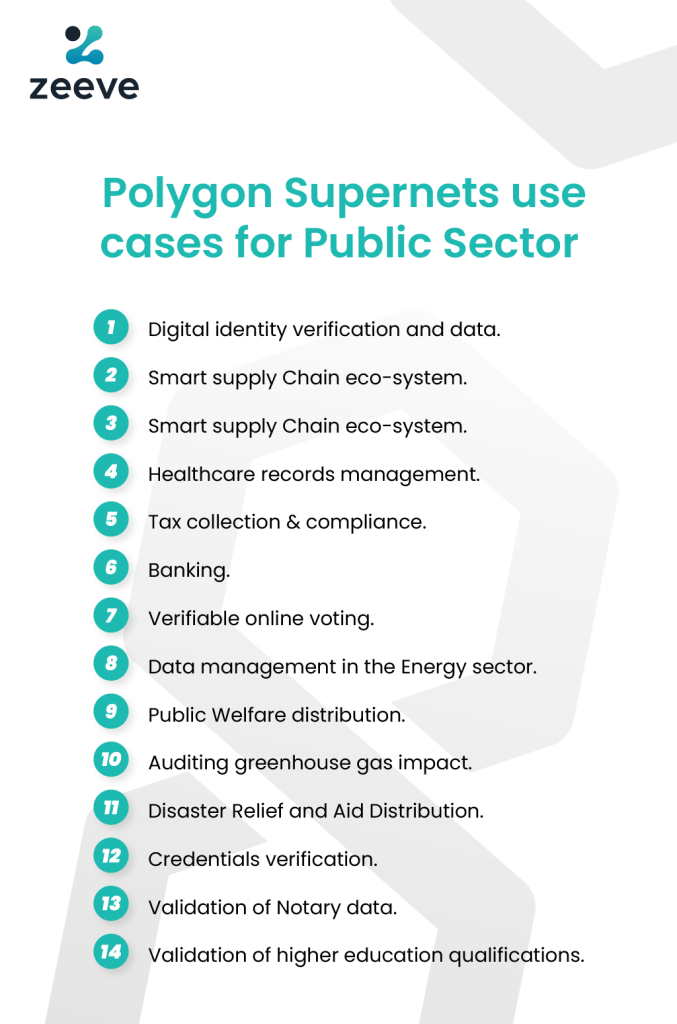
Conclusion
With Polygon Supernets evolving fast, there’s no doubt that more revolutionary Polygon Supernets use cases for public sector enterprises will be introduced. Along with that, the number of Public sector enterprises that use appchain infrastructure for their use cases will rise significantly, and supernets will definitely be one of the frontrunners. Hence, enterprises can themselves experiment with Supernet and build highly feasible solutions.
Launching Polygon Supernets becomes easy with managed web3 infrastructure service providers like Zeeve. We provide everything you need for a quick AppChain launch, from scalable nodes and cloud servers to associated infrastructure components like- wallets, testnet faucets, white-labeled explorers, data indexing protocols like Subgraphs and Subquery, and more. If you are planning to launch your own Polygon Supernets or any other AppChain, we are ready to help! Connect with our blockchain experts and discuss your project requirements.


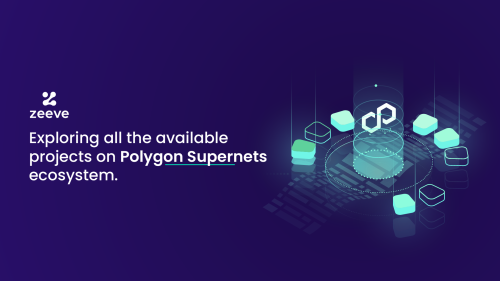

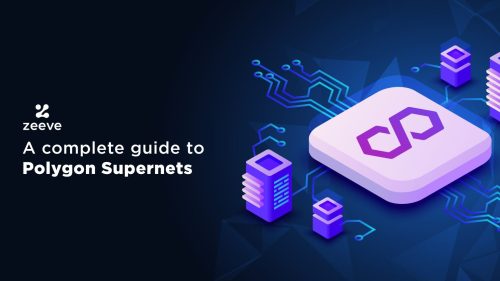
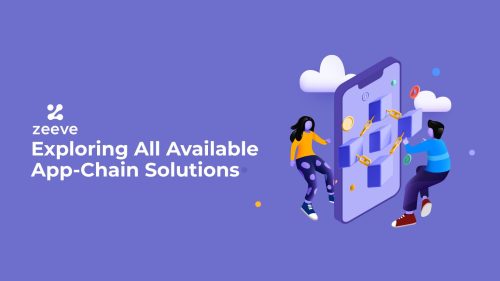
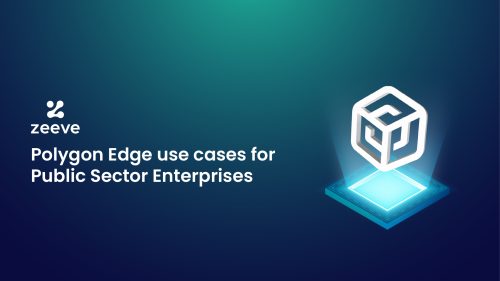
Responses